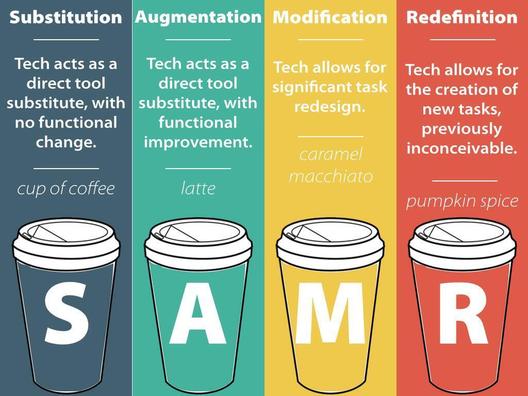I’ve long been interested in seeing the use of technology in the classroom as an almost invisible tool, a stage for which the children and the learning process are the stars. I often watch technologies trickle away after the novelty has faded, making me wonder how technology is valued.
I endeavour to regard learning tech as merely the metaphorical stage, rather than the actor, in this show of learning.
Take, for example, the humble scanning app FineScanner (or similar). In the middle of a lesson, a piece of student work can be scanned and projected instantly onto the screen or sent to student devices for illustrative purposes. This simple act is an example of a versatile portion of the stage that permeates lessons where needed. I would place it in the category of Augmentation (as part of Puentedura’s SAMR Model), mentioned in a previous blog post, that enhances learning without necessarily transforming the pedagogical landscape.

Although, I was interested in how technology can transform the stage without it overshadowing the learning performance. Enter, the parallel Socratic discussion.
The Socratic discussion of literature is a tried and tested method for developing critical thinking skills in a literacy context. However, holding a whole-class discussion often leads to the inevitable eager few taking control while the teacher coaxes responses from others. Often, the thoughts are there in the minds of these quiet children, but the medium – speaking – constrains the words. A task Modification was needed.
My students loved reading Fox by Margaret Wild and Ron Brooks and had plenty to say, but they needed the media to do so. Using the iPad app Padlet (also available in web-browsers), I held parallel and intersecting discussions: one oral, the other as a written discussion thread. At all times, all students had access to both and could weave between the two modes however they liked. For example, while some students orally debated the meaning of Magpie’s betrayal of Dog, many others would chime in on their iPads with ideas that add to, counter or extend the live responses (see the screenshot example).

The technology allowed for a new stage to be set whereby engagement in the content of the lesson was ubiquitous. We cannot assume that the pace of a lesson is going to be appropriate for all students. This parallel discussion allowed the discussion to move at two paces while facilitating the different modes of thinking that come with speaking and writing. It allows the teacher to move the discussion forward while students have their final say on a given topic.
While not completely redesigning a classical lesson, the use of Padlet created a higher quality and greater volume of discourse, engaging all voices through dynamic media, in a way that wouldn’t have been possible without technology. It is also the type of lesson that relies on the quality of the discussion led by the teacher focusing on the intended literacy outcomes.
The actors are the stars (but the stage looks pretty cool, too).
Author: Brett Healey has taught in primary schools in the U.K., Australia and Hong Kong (where he is currently based) specialising in Literacy. He has a love of post-modern picture books and is the author of the teacher’s resource: Lifting the Lid on Words and Pictures – a walkthrough for educators interested in promoting critical and creative thinking skills through literature inquiry.
Find him on Twitter: @MrBWHealey.


